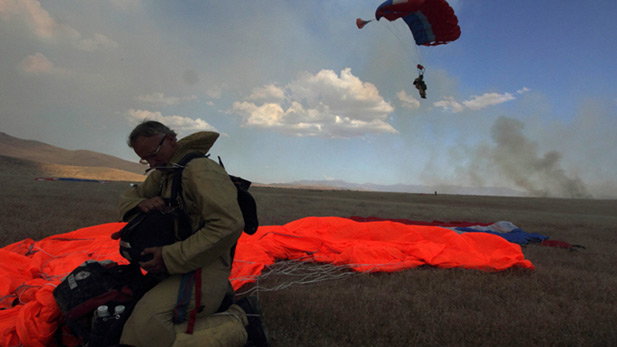
Story by Mónica Ortiz Uribe
Fronteras Desk
Listen:
Wildfire season is here, with Arizona and the rest of the West Coast highly vulnerable.
When wildfires break out, the first on call are smoke jumpers.
Jeff Davis spent nine fire seasons north of the Gila National Forest chasing smoke.
At age 77, with a fragile back, his backcountry days are done. Still, he manages to run 8 miles everyday. Staying in shape is programmed into his psyche. It was a key of his life as a smokejumper - arguable the most thrilling job in the U.S. Forest Service.
"We're a firefighter," he said. "The only difference is our means of access to the fire. We jump in. We go in by parachute. And the purpose is we can get there fast. Faster than anybody."
The idea is to put the fire out before it has a chance to grow.
"We used to drop 1,000 feet above ground level," Davis said. From 1,000 feet, you've got 11 seconds from the door to the ground if your chute doesn't open. Time kinda slows down. You're right in the moment. You're acting just by instinct."
Smoke jumpers often drop into unfamiliar terrain. Once on the ground, they're pretty much on their own. They've got a chunk of map and 120 pounds of gear on their back.
"We grab our tools and we go to the fire," Davis said.
They put the fire out, not with water, but with muscle. Using shovels and pulkaskis they dig a line around the flames. The line resembles a forest trail.
"The temperature might be 100, 110 even, and we just, sweating like pigs, radiant heat was just bringing us good," he said.
The smokejumpers might stick around for days watching for hot spots. They camp out and content with the elements, whether it's a rainstorm or a grizzly bear. But that never bothered Davis.
"And it wasn't a job, it wasn't a career, it was love affair," he said.
He described the easy fires like paid vacations with spectacular scenery. Then there were the ugly fires. Wild, uncontrollable blazes that cost firefighters their lives. Davis witnessed these in California, where the greasewood acts like matches doused in diesel.
"You watch a whole hillside just suddenly painted with fire," he said. "It went up that hill so fast you couldn't even imagine it. And the sound you can't hear and the fury of it."
Some develop into firestorms with temperatures that can reach 2,000 degrees Fahrenheit. They'll even create their own weather. Davis remembers rescuing a crew from the destructive Coyote Fire near Santa Barbara in 1964. He saw a man staggering up a cliff with his arms stretched out.
"So I went running over to him and I grabbed his arm to pull him out of that burn and all his skin on his whole arm slid off like a barbecued chicken," Davis said.
Today, Davis's apartment in Silver City, NM is a shrine to his profession. Old photographs cover the walls. He makes model smokejumpers with clay and Barbie dolls. It's obvious he misses it.
"An old jumper buddy of mine. A couple of years ago he calls me and says, 'I think we can get you out on one of these skydiving clubs,'" he said.
The only catch was Davis had to do it strapped to another skydiver-- for health reasons.
"I says, hell no, I'm not cargo. I'm a jumper. I'm either jumping or forget that. And if I got a chance today, I'd do her. My fake hip would fall out and stick in the air and my pacemaker would take some extra thumps and a few other…" he said.
Nowadays, Davis gets by on a modest disability check. The younger jumpers know that. At the end of fire season, they'll leave a care package at his door.
"We're brothers. Whether they're men or women, we're bros," he said. "We cover each other's butts. We watch each other, we save each others lives or we hold the ones that die in our arms. And we get them out of there, we don't leave anybody behind."

By submitting your comments, you hereby give AZPM the right to post your comments and potentially use them in any other form of media operated by this institution.